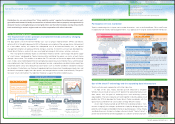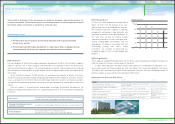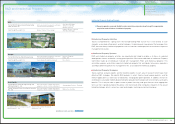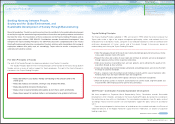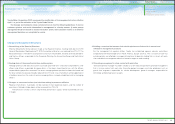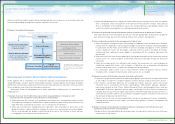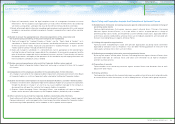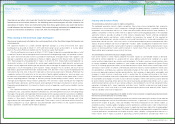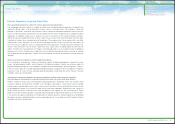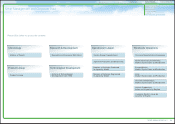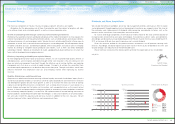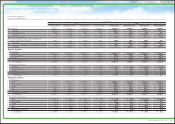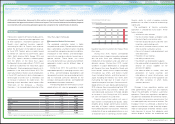Toyota 2011 Annual Report Download - page 35
Download and view the complete annual report
Please find page 35 of the 2011 Toyota annual report below. You can navigate through the pages in the report by either clicking on the pages listed below, or by using the keyword search tool below to find specific information within the annual report.
Management and
Corporate Information
Business and
Performance Review
Financial Section and
Investor InformationSpecial Feature
Message/Vision
Risk Factors
Operational and other risks faced by Toyota that could significantly influence the decisions of
investors are set out below. However, the following does not encompass all risks related to the
operations of Toyota. There are risk factors other than those given below. Any such risk factors
could influence the decisions of investors. The forward-looking statements included below are
based on information available as of June 24, 2011, the filing date of Form 20-F.
Risks relating to the Great East Japan Earthquake
Toyota may be adversely affected by the continuing effects of the Great East Japan Earthquake and
ensuing events.
The Japanese economy as a whole suffered significant damage as a result of the Great East Japan
Earthquake that occurred on March 11, 2011 and the ensuing tsunami and accidents at nuclear power
plants in Fukushima Prefecture (collectively, the “Great East Japan Earthquake”).
After the earthquake’s occurrence on March 11, 2011, Toyota temporarily suspended operations at all of
its domestic factories due to damage to social infrastructure including energy supply, transportation systems,
gas, water and communication systems caused by the earthquake, shortages of parts from suppliers, and
damage sustained by some subsidiaries of Toyota in regions adjacent to the disaster zone. On March 18,
2011, Toyota began resuming production in stages. As of April 18, 2011, Toyota had resumed operations at
all domestic factories. As of the date of this annual report, production levels at both domestic and overseas
factories vary by region and vehicle type and, primarily due to shortages of supplies from external suppliers,
production is not yet normalized at some factories. Toyota anticipates that its factories will reach normal
operational capacity between November and December 2011, but there is no assurance that production will
normalize by that time. Also, in May 2011, operations at the nuclear power plant in Shizuoka Prefecture that
supplied a portion of the electricity to the area where Toyota’s global headquarters and main plants are
located were suspended in light of the damage sustained by the Fukushima nuclear power plant. There is
concern regarding potential shortages of electricity during the demanding summer months, and such a
shortage could negatively impact Toyota’s production. The Great East Japan Earthquake has negatively
impacted Toyota’s operations and the duration and magnitude of the impact ensuing from it remain unclear.
Depending on developments, the impact on Toyota’s results of operations and financial condition may be
significant.
The Japanese economy has been negatively impacted by damage caused by the Great East Japan
Earthquake, costs associated to rebuild the affected areas and interrupted infrastructure, including energy
shortages. The duration and magnitude of the total impact on the Japanese economy are unclear. In addition,
the nuclear power plants in Fukushima Prefecture are not yet fully under control and the resolution of the
situation at these plants, including timing, remains unclear. Continuing radiation leakage and further
aggravation of the nuclear power plants are possible. These various issues in connection with the Great East
Japan Earthquake may cause significant and unforeseeable adverse effects on the Japanese economy,
Toyota’s operations, and demand for Toyota’s products.
Industry and Business Risks
The worldwide automotive market is highly competitive.
The worldwide automotive market is highly competitive. Toyota faces intense competition from automotive
manufacturers in the markets in which it operates. Although the global economy is gradually recovering,
competition in the automotive industry has further intensified amidst difficult overall market conditions. In
addition, competition is likely to further intensify in light of further continuing globalization in the worldwide
automotive industry, possibly resulting in further industry reorganization. Factors affecting competition
include product quality and features, safety, reliability, fuel economy, the amount of time required for
innovation and development, pricing, customer service and financing terms. Increased competition may
lead to lower vehicle unit sales, which may result in a further downward price pressure and adversely affect
Toyota’s financial condition and results of operations. Toyota’s ability to adequately respond to the recent
rapid changes in the automotive market and to maintain its competitiveness will be fundamental to its future
success in existing and new markets and to maintain its market share. There can be no assurances that
Toyota will be able to compete successfully in the future.
The worldwide automotive industry is highly volatile.
Each of the markets in which Toyota competes has been subject to considerable volatility in demand.
Demand for vehicles depends to a large extent on social, political and economic conditions in a given
market and the introduction of new vehicles and technologies. As Toyota’s revenues are derived from sales
in markets worldwide, economic conditions in such markets are particularly important to Toyota. During
fiscal 2010, although government efforts to stimulate demand in Japan, North America and Europe, which
are Toyota’s main markets, resulted in a trend towards economic recovery, market conditions in those areas
remained difficult, and Toyota was adversely affected by changes in the market structure with further shifts
in consumer demand to compact and low-priced vehicles. Such weakness in demand for automobiles and
changes in market structure is continuing, and it is unclear how this situation will transition in the future.
Toyota’s financial condition and results of operations may be adversely affected if the weakness in demand
for automobiles and changes in market structure continue or progress further. Demand may also be affected
by factors directly impacting vehicle price or the cost of purchasing and operating vehicles such as sales
and financing incentives, prices of raw materials and parts and components, cost of fuel and governmental
regulations (including tariffs, import regulation and other taxes). Volatility in demand may lead to lower
vehicle unit sales, which may result in a further downward price pressure and adversely affect Toyota’s
financial condition and results of operations.
Toyota’s future success depends on its ability to offer new innovative competitively priced products
that meet customer demand on a timely basis.
Meeting customer demand by introducing attractive new vehicles and reducing the amount of time required
for product development are critical to automotive manufacturers. In particular, it is critical to meet customer
demand with respect to quality, safety and reliability. The timely introduction of new vehicle models, at
competitive prices, meeting rapidly changing customer preferences and demand is more fundamental to
Toyota’s success than ever, as the automotive market is rapidly transforming in light of the changing global
economy. There is no assurance, however, that Toyota will adequately and appropriately respond to changing
customer preferences and demand with respect to quality, safety, reliability, styling and other features in a
timely manner. Even if Toyota succeeds in perceiving customer preferences and demand, there is no
0725
R&D and Intellectual Property
Corporate Philosophy
Management Team
Corporate Governance
Risk Factors
Other Management and Corporate Data
35TOYOTA ANNUAL REPORT 2011


